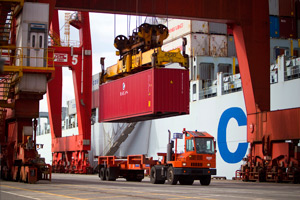Canadian Ports Win as Ships Avoid US on Labor Concern

Prince Rupert, a remote port luring tourists with the slogan “Where Canada’s Wilderness Begins,” may want to consider a new motto: “Asia’s Gateway to Chicago.”
Container ships sailing across the northern Pacific are carrying more cargo and are setting course for British Columbia to avoid delays from a possible strike by U.S. West Coast longshoremen. Traffic in Prince Rupert soared 49% in July from a year earlier, according to data compiled by Bloomberg Intelligence, while volume dropped 19% in Seattle, its nearest major U.S. rival.
Canadian ports are gaining an advantage over their U.S. rivals amid an economic recovery that’s increasing container volumes from East Asia. While U.S. West Coast ports are mired in a labor dispute and congestion hobbles local railways, Prince Rupert is winning customers with its shorter sailing times from China and efficient infrastructure that can whisk freight to the U.S. Midwest and beyond.
“If people are using the Canadian ports now out of concern for a slowdown, and they like what they see and they like the processing times and the experience, they’ll continue to funnel some of their traffic that way,” Emma Griffith, a director at Fitch Ratings in New York who covers air and sea ports, said by phone Aug. 19.
One of the companies best positioned to benefit from the added traffic is Canadian National Railway Co. The Montreal-based company, which rose to a record yesterday in Toronto trading, has exclusive connections to Prince Rupert and its lines help make the port a linchpin in the quickest sea-and-land route linking East Asia and the U.S. Midwest, according to the Prince Rupert Port Authority.
Container traffic is rising on both sides of the continent. The volume at the biggest U.S. and Canadian ports rose 7.2% from a year earlier in May, the latest month for which industrywide data has been published, according to Bloomberg Intelligence. That outpaced April’s 5.9% gain.
The container volume indicates there’s strength in the U.S. economic rebound, according to Tony Hatch, a New York-based transportation analyst at ABH Consulting.
“The underlying demand is pretty strong, and this suggests that the economy is going well,” Hatch said in a phone interview.
Prince Rupert may be uniquely positioned to benefit from the situation. The town, which lies ice-free 745 kilometers (462 miles) northwest of Vancouver, is as many as 68 hours closer to Shanghai in sailing time than is Los Angeles, according to the Prince Rupert Port Authority.
This kind of traffic, which uses different modes of transportation, is known within the industry as intermodal freight, and it’s booming for Canadian National. Its intermodal revenue jumped 17% to C$716 million ($654 million) in the second quarter.
Volume at Prince Rupert has been increasing for five months, according to the data compiled by Bloomberg Intelligence. In July, Prince Rupert handled 64,355 standard containers, or 20-foot equivalent units (TEUs), a record according to the data.
Container traffic also has increased at Vancouver’s port, Prince Rupert’s larger Canadian rival. Inbound containers reached a record in July, John Parker-Jervis, a spokesman for Port Metro Vancouver, said by phone last week. The gateway handled a total of 274,115 TEUs in May, the last month for which published data is available.
Prince Rupert and Vancouver moved less cargo than Los Angeles, which handled 717,408 TEUs last month, and Long Beach, California, which saw 583,060 TEUs. Still, Prince Rupert is considering whether to almost double its annual capacity to about 1.3 million TEUs, Schumacher said.
In the U.S., there’s no indication when new contracts will be signed for workers at 29 ports from Washington state to California. About 20,000 dockworkers represented by the International Longshore and Warehouse Union have been without a contract since early July. The union and the maritime association are negotiating over work rules, salaries and health-care benefits.
Still, the threat posed to U.S. ports is real. While growth this year in container traffic at the Port of Los Angeles doesn’t suggest a loss of business to the Canadians, the shipping industry is “anxious” for a labor agreement, Phillip Sanfield, a port spokesman, said by phone.
For its part, the Port of Seattle has lost container volumes because of the possibility of a strike, said Peter McGraw, a spokesman.
“We value the cargo here,” he said by phone. “Cargo means jobs.”

